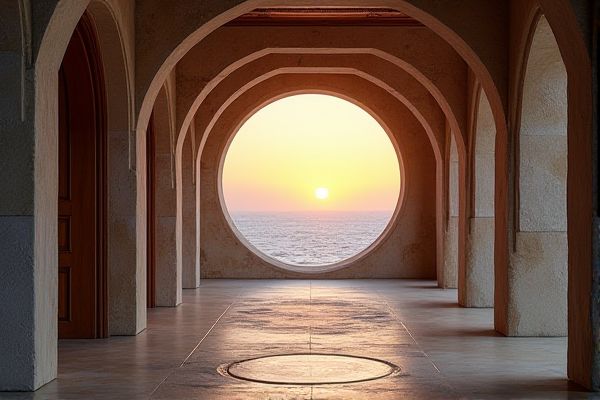
Moon gates offer a circular, symbolic entrance often associated with tranquility and traditional Asian garden design, while archways provide versatile, structural openings suitable for various architectural styles and practical purposes. Explore the rest of the article to discover which option best enhances your outdoor space and complements your design vision.
Table of Comparison
| Feature | Moon Gate | Archway |
|---|---|---|
| Shape | Perfect circle | Curved or semicircular |
| Origin | Chinese garden architecture | Classical and Gothic architecture |
| Symbolism | Harmony, perfection, transition | Strength, support, entry |
| Primary Use | Decorative garden entrance | Structural doorway or passage |
| Materials | Stone, brick, wood | Stone, brick, concrete, metal |
| Design Complexity | Simple, minimalistic | Varies from simple to ornate |
| Common Locations | Gardens, parks | Buildings, bridges, gates |
Introduction to Moon Gates and Archways
Moon gates and archways serve as distinctive architectural features that enhance garden aesthetics and structural design. Moon gates, characterized by their circular openings, symbolize harmony and serve as inviting passageways rooted in Chinese garden traditions. Archways, typically featuring a curved or pointed top, provide structural support while framing views and adding elegance to entrances in various architectural styles.
Historical Origins of Moon Gates
Moon gates, originating from traditional Chinese gardens, symbolize harmony and tranquility, often crafted as circular openings representing the full moon. Unlike archways, which have roots in Roman and European architecture as structural support and decorative elements, moon gates serve a cultural and spiritual purpose. Your garden can benefit from a moon gate's unique historical charm, blending aesthetic elegance with meaningful symbolism.
Historical Background of Archways
Archways have been integral to architectural history since ancient civilizations like Mesopotamia, Egypt, and Rome, where they symbolized strength and grandeur while serving functional purposes such as supporting structures and marking entrances. Unlike moon gates, which originated in traditional Chinese gardens as circular openings symbolizing harmony and transition, archways evolved as versatile architectural elements spanning Roman aqueducts and Gothic cathedrals. The enduring use of archways across diverse cultures highlights their significance in engineering innovation and cultural expression throughout history.
Architectural Differences Between Moon Gates and Archways
Moon gates are circular openings often found in traditional Chinese gardens, characterized by their round shape symbolizing harmony and unity, while archways feature a variety of shapes including semi-circular, pointed, or flat tops used in diverse architectural styles worldwide. Moon gates typically serve as ornamental passages blending seamlessly with natural surroundings, whereas archways function as structural elements that support weight and frame entrances. The construction of moon gates often involves stone or brick with smooth curves, contrasting with archways that may utilize keystone techniques and diverse materials for enhanced stability and decorative impact.
Symbolic Meanings: Moon Gate vs Archway
Moon gates symbolize harmony, unity, and transition, often representing a passage into a serene, sacred space within gardens, inspired by traditional Chinese architecture. Archways convey strength, welcome, and grandeur, frequently marking entrances to important buildings or ceremonial areas, emphasizing architectural dominance. Your choice between a moon gate and an archway depends on whether you prefer a tranquil, spiritual symbol or a bold, structural statement.
Material Choices and Construction Methods
Moon gates are traditionally constructed using stone or concrete, emphasizing circular shapes that require precise masonry skills to ensure structural integrity and smooth curvature. Archways often incorporate a variety of materials such as brick, stone, wood, or steel, with construction techniques relying on keystone placement and load distribution to support different architectural styles. Both structures demand specialized craftsmanship, but moon gates focus more on aesthetic circular form, while archways prioritize diverse material usage and functional strength.
Functional Uses in Landscape and Architecture
Moon gates are circular openings often found in Asian-inspired gardens, serving as symbolic passageways that frame views and invite contemplation, while archways are structural elements in architecture designed to support weight over doorways or pathways, facilitating movement and enhancing aesthetic appeal. Moon gates emphasize creating a harmonious connection between garden spaces and natural surroundings, often used as focal points in landscaping to guide visitors visually and spiritually. Your choice depends on whether you prioritize symbolic, cultural significance and garden aesthetics (moon gate) or structural functionality and broader architectural application (archway).
Aesthetic Impact on Garden and Outdoor Design
Moon gates introduce an elegant, circular focal point that enhances garden harmony through their symbolic and soft curves, creating a sense of tranquility and balance in outdoor spaces. Archways offer versatility with their varied shapes and sizes, providing a dramatic framework that can complement both modern and traditional garden styles. Both features significantly influence spatial flow and visual interest, but moon gates are often preferred for their unique cultural resonance and artistic appeal.
Cultural Significance in Eastern and Western Contexts
Moon gates, rooted in Chinese garden design, symbolize harmony and the cyclical nature of life, often serving as spiritual portals that invite contemplation and transition. Archways in Western architecture represent strength and grandeur, frequently marking significant entrances or celebrations in historical and cultural contexts. Your choice between a moon gate and an archway reflects a preference for either Eastern philosophies of balance and tranquility or Western ideals of monumentality and ceremonial passage.
Choosing Between Moon Gate and Archway for Your Project
Moon gates create a unique focal point with their circular shape, symbolizing harmony and continuity, making them ideal for garden and landscape projects emphasizing tranquility. Archways provide versatile design options with varied shapes and materials, suitable for both traditional and modern settings that require structural support or decorative function. Selecting between a moon gate and an archway depends on the desired aesthetic, cultural symbolism, and the architectural integration within your project.
 homyna.com
homyna.com